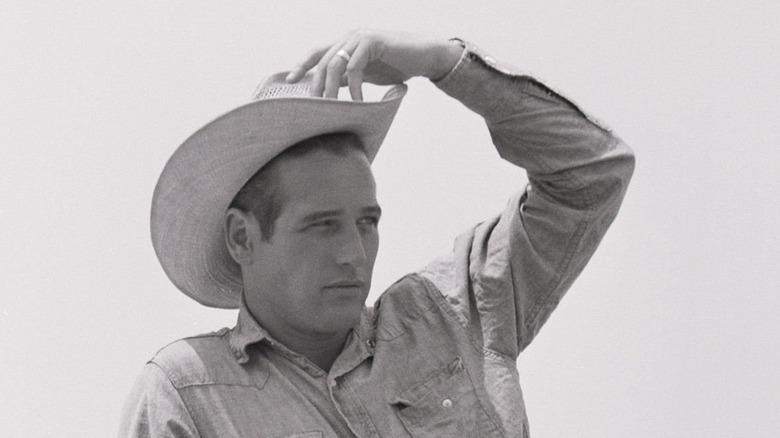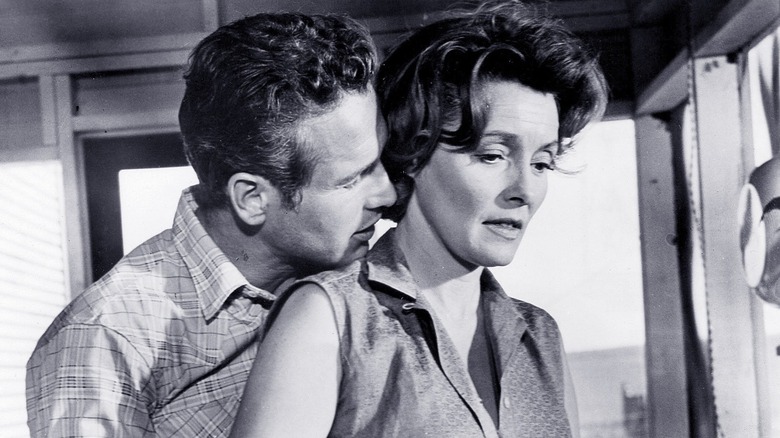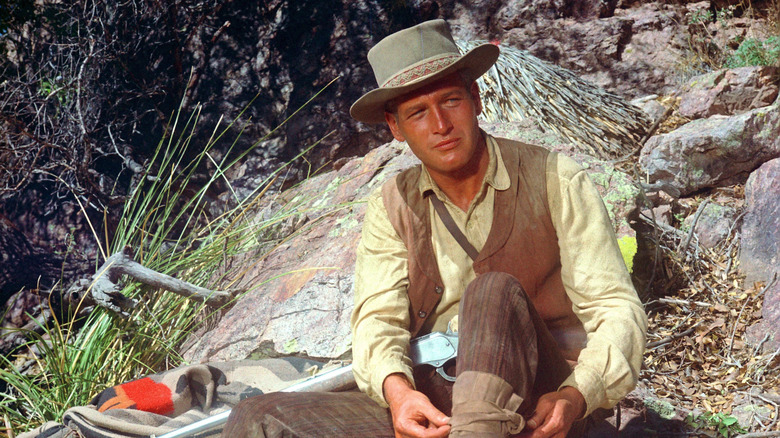Paul Newman Made Some Of The Greatest Westerns Ever With One Director
When it comes to ranking the best Western movie actors, Paul Newman rarely troubles the likes of John Wayne, Clint Eastwood, and Gary Cooper at the top of all-time lists. Sure, one of his most beloved movies was starring alongside Robert Redford in "Butch Cassidy and the Sundance Kid," but arguably his most iconic roles were brooding outsiders like Eddie Felson in "The Hustler" and Luke Jackson in "Cool Hand Luke." Even so, Newman starred in his fair share of Westerns over the course of his career, putting in big performances for Arthur Penn in "The Left-Handed Gun," John Huston in "The Life and Times of Judge Roy Bean," and Robert Altman in "Buffalo Bill and the Indians, or Sitting Bull's History Lesson." He also made two of the greatest Westerns ever with one particularly underrated director, Martin Ritt.
Ritt is arguably one of the most unsung Hollywood filmmakers, working in a range of genres from the late 1950s until his disappointing final film, "Stanley & Iris," in 1990. His reputation survived getting blacklisted from television work in the early '50s by the House Un-American Activities Committee (HUAC), later moving into directing movies once the Red Scare hullabaloo had died down. His debut feature, "Edge of the City," was well-received, but it was his next picture that paved the way for his fruitful relationship with Paul Newman.
"No Down Payment" starred Joanne Woodward, who had first met Paul Newman while they were working on a Broadway show called "Picnic" in 1953. RItt cast them both in "The Long, Hot Summer" and the pair became romantically involved during the production, marrying in 1958. The film was hailed as Ritt's major comeback and Newman's star-making role, earning him the Best Actor Award at the Cannes Film Festival. Newman and Woodward would go on to make a further 15 movies together, one of them ("Paris Blues") also directed by Ritt. Ritt and Newman collaborated on five more pictures, and they might have made it seven in total if Ritt's version of "First Blood" with Newman as John Rambo got off the ground. Sadly, that never came to pass, but we still have "Hud" and "Hombre," two of the best revisionist Westerns to come out of the 1960s.
Hud (1963)
Paul Newman was one of those actors who carried themselves with an innate sense of decency, but he was often at his best when playing unheroic characters with dubious morals. Few of his characters are as utterly irredeemable as Hud Bannon in "Hud," a powerful saga about three generations of a Texas ranch family battling it out when their herd is stricken with foot-and-mouth disease.
Head of the household is ageing Homer (Melvyn Douglas), an Old Timer with a strict sense of principles; his son Hud (Newman), is a mean-spirited and bitter drunk who cares for nobody but himself; and Hud's nephew Lonnie (Brandon deWilde), is a guileless but level-headed teenager who looks up to his uncle. The fourth wheel is their earthy housemaid Alma (Patricia Neal), who mothers Lonnie and flirts with the womanizing Hud.
Adapted from Larry McMurtry's "Horseman, Pass By," "Hud" unfolds at the pace of a good novel as the three men clash about their future. Hud has no qualms about selling the herd before word of the disease can get out and drilling for oil instead, but Homer is determined to do the right thing and prevent an epidemic if it means financial ruin. Lonnie and Alma find themselves caught between the two.
Much like "The Last Picture Show" (for which McMurtry also provided the source material), "Hud" is a quiet elegy for a way of life rapidly losing ground to modernity. Horses and cows give way to Cadillacs and bulldozers, which pains Homer. He still values the old cowboy way of honest hard work on the land while Hud represents cynical and opportunistic capitalism, happy to tear up the family ranch to get rich quick from oil. Hud is such a blisteringly nasty and amoral character that he would be almost impossible to watch without an actor as charismatic as Newman in the role. The performance earned him his second Oscar nod.
"Hud" is a strong piece of storytelling with excellent performances all round. Douglas and Neal both won Academy Awards for their work, and Ritt's patient direction earned him the only Oscar nomination of his career. The film looks a treat, too, with James Wong Howe's beautiful black-and-white photography giving it a timeless feel. Howe deservedly took home an Oscar for his work. "Hud" may not be an action-packed western, but it is one that lingers long after the final credits roll.
Hombre (1967)
At first glance, "Hombre" looks far more like a traditional Western than "Hud." It is set in the 1870s and shot in gorgeous widescreen Technicolor by James Wong Howe, who was teaming up with Ritt and Newman again after "Hud" and "The Outrage," their Western remake of "Rashomon." Newman plays John Russell, a stoic white man who was abducted and raised by Apaches as a kid. When his father dies and leaves him a boarding house, Russell is encouraged to cut his hair and blend in with white society again. He's not interested in running a hotel, however, and decides to sell the house and take the stagecoach out of there.
Also along for the ride are a motley bunch of characters. Among them are Mendez the driver (Martin Balsam, playing a Mexican); Jessie (Diane Cilento), the boarding house manager who now finds herself unemployed; Cicero Grimes (Richard Boone), a menacing cowboy; and Dr. Favor (Fredric March), a seemingly upstanding citizen who has embezzled $12,000 intended for the Apache Nation. Russell faces prejudice due to his upbringing with indigenous people, but the passengers must rely on him for survival when they are ambushed by a posse of bandits.
Adapted from Elmore Leonard's novel, Martin Ritt's film takes a grown-up approach to the material. The story seems to be in direct dialogue with the Westerns of John Ford and resembles an inversion of "Stagecoach." In that movie, the Duke defended his fellow passengers from marauding Apache warriors, which might as well be a horde of zombies for all the human characteristics they are given. This time, the gang must trust a man who was raised by the very people they despise.
It was a pertinent change of perspective because "Hombre" came along when Hollywood was starting to take a more responsible approach to how indigenous Americans were portrayed in Western movies. Just three years earlier, John Ford had offered his final western "Cheyenne Autumn" as an apology for how he had misrepresented Native Americans in his earlier work, and later film like "Little Big Man" and "Soldier Blue" would tackle the subject of genocide and exploitation head-on. "Hombre" has received some criticism for casting a blue-eyed all-American boy like Paul Newman in the lead, but his performance sums up what made him so appealing as an actor: The ability to say so much by saying so little.


